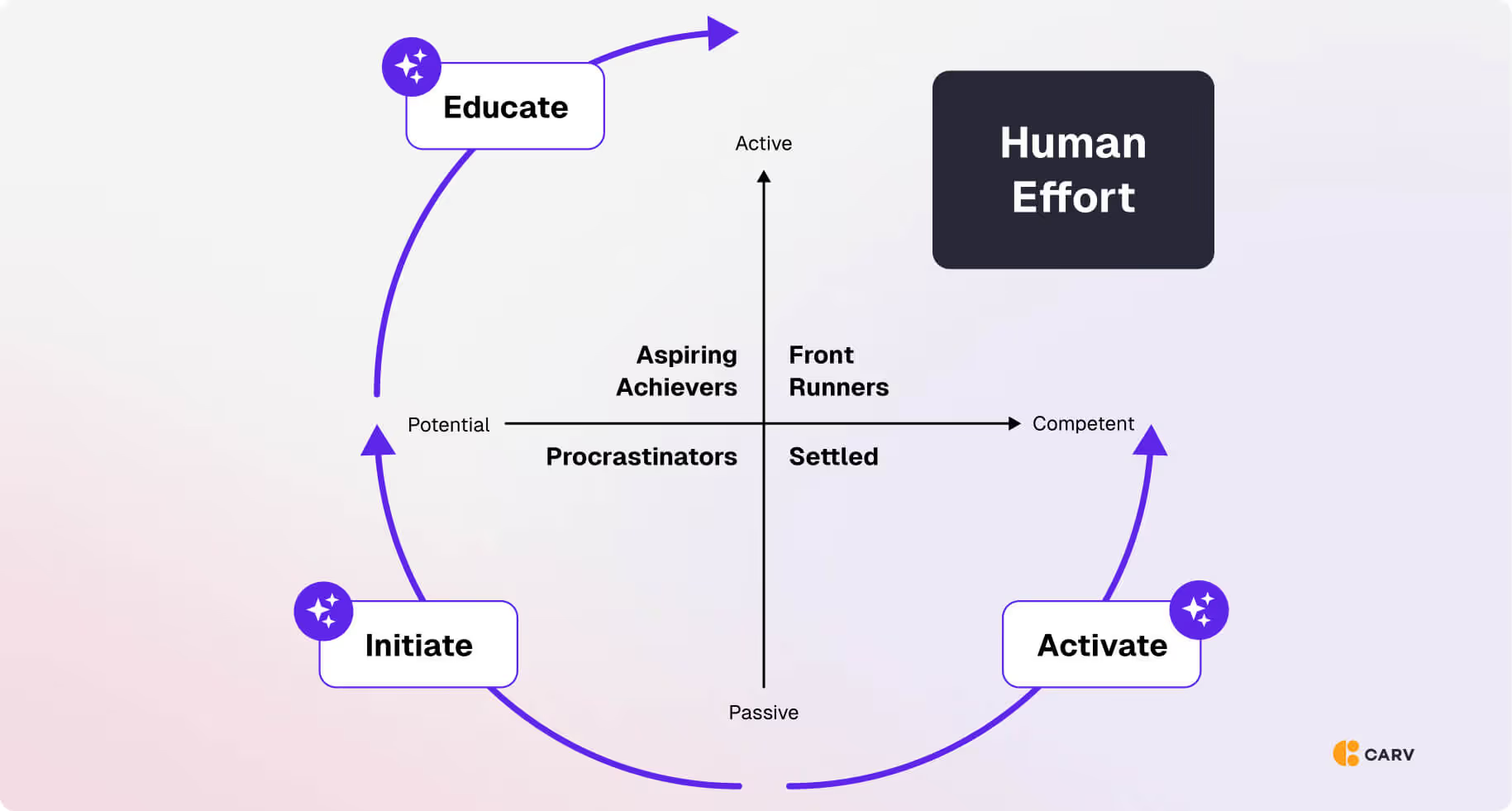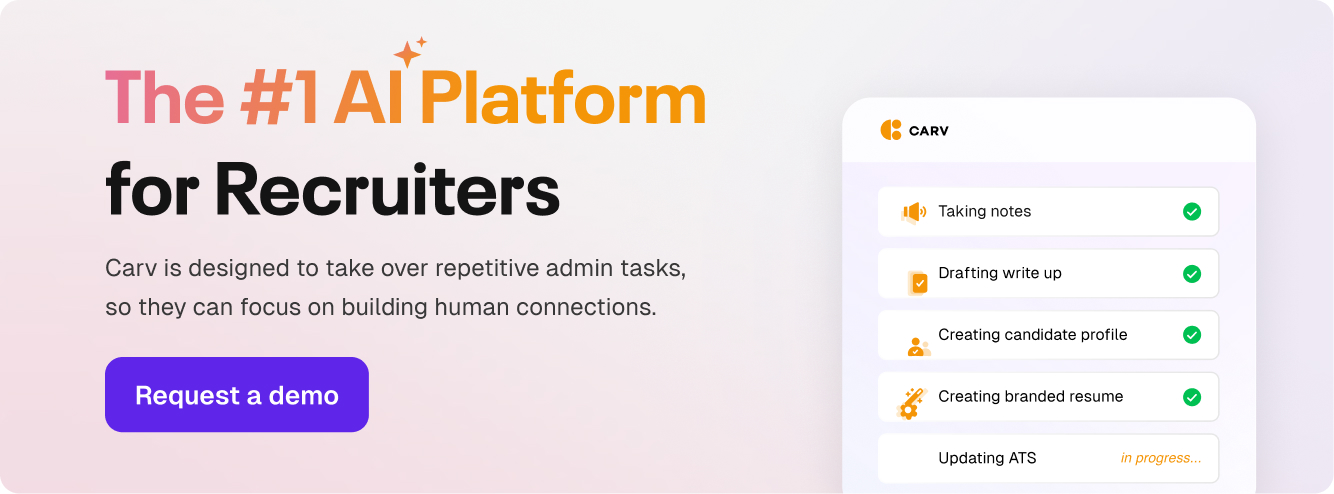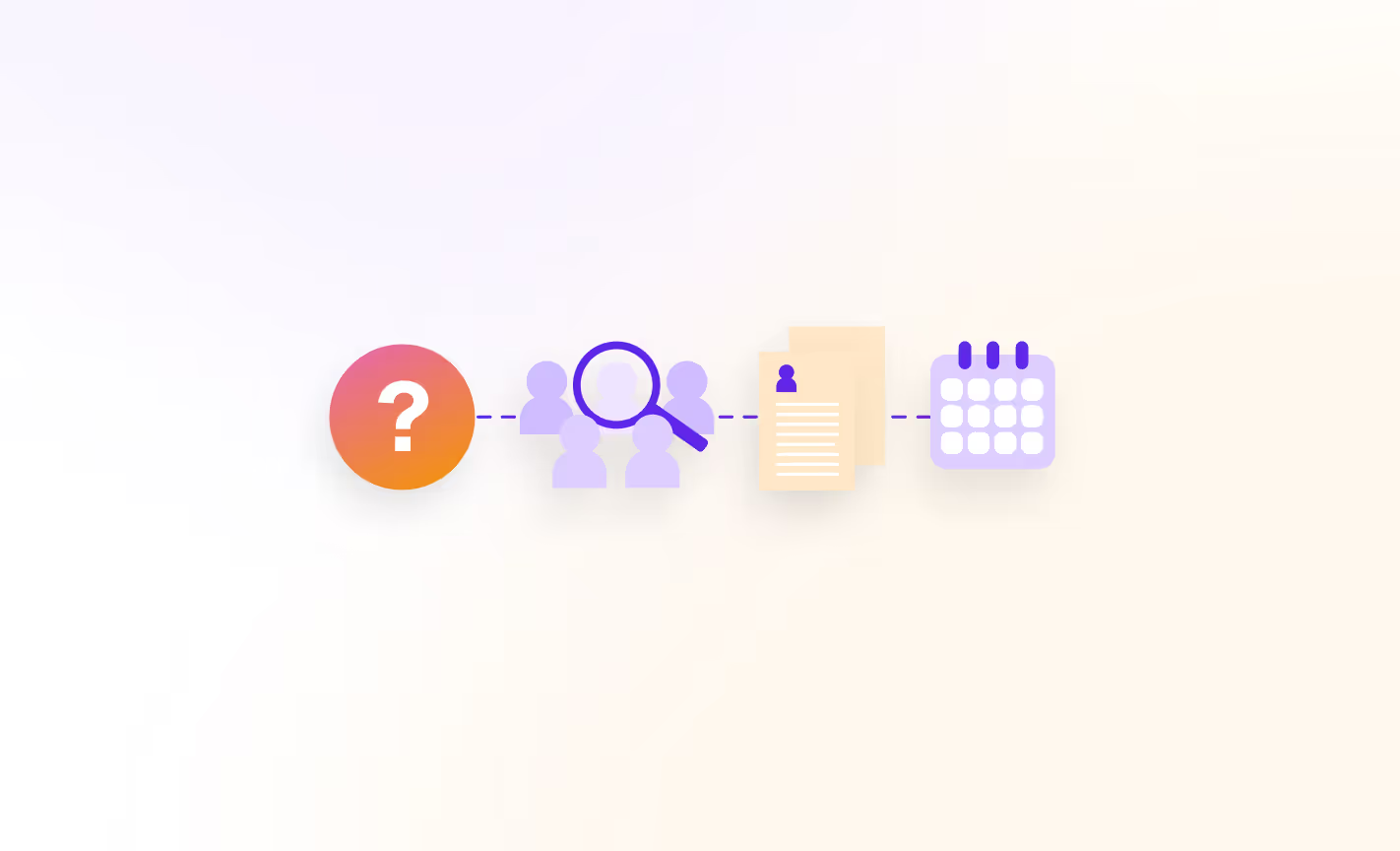Since we started our journey building Carv - AI specifically designed to help recruiters, we've seen firsthand the challenges you face. Growing workloads, shrinking teams – the pressure to find top talent is real, and current tech solutions often feel like adding another layer of complexity.
You know AI tools have the potential to revolutionize recruitment, but where do you even begin? Integrating complex AI software with your existing stack sounds like a nightmare.
So I want to take a few moments and offer you a different approach.
Forget the all-or-nothing AI takeover.
At Carv, we've developed a practical implementation framework designed to help recruitment teams integrate AI into their hiring process without feeling overwhelmed.
So I'll show you how to leverage AI to cut administrative tasks, automate talent pool and client engagements, and ultimately free up your time to focus on what matters most: building a stellar team for your company or client.
Let's dive in!
What’s keeping TA teams from adopting AI?
We've been talking to recruiters at companies of all sizes, from scrappy startups to industry giants. And guess what? The challenges they face with AI adoption are surprisingly similar.
Now, I’ve covered this topic in-depth in a previous article about the adoption of AI in recruitment, so I won’t spend too much time on it. But I want to give a quick overview of the main blockers, to make sure this resonates with you.
Analysis paralysis
The sheer number of potential AI recruitment tools and gen AI use cases and the lack of a holistic approach can lead to confusion and inaction. Many teams struggle to see how AI can fit into their existing workflow and streamline their recruitment process.
Should they use AI for screening candidates? Or is it better to not delegate this part to AI recruitment tools, and focus on automating other steps of the process, like writing job descriptions and scheduling interviews instead?
AI recruiting software using generative AI can do so many things that it’s easy to feel overwhelmed without a clear big picture and vision for the future in mind.
So the first blocker is that organizations lack a clear path to start leveraging AI's benefits and a practical roadmap for AI-powered recruitment.
Existing tech stack complexity
Many HR and recruitment teams we talk to already manage complex software ecosystems. Integrating AI tools on top of that can feel like a daunting additional layer, requiring significant time and resources for configuration and troubleshooting. Thus, the complexity of adding separate AI-powered tools discourages implementation.
This doesn't mean recruiters aren't dipping their toes into the waters and looking at the different ways to use AI into their daily work. They're aware of the potential benefits – like automating repetitive tasks, filtering resumes more efficiently, and even finding potential candidates by letting AI browse through job boards and social media platforms like LinkedIn.
But the idea of adding yet another layer of software, with its own learning curve and integration headaches, feels like a step backwards. As a result, most recruiters stop at tools like ChatGPT and point solutions like interview schedulers, chatbots, and generic job description generators.
But with this approach, they might get the impression that AI tools are one-size-fits-all solutions, lacking the customization and personalization that some TA teams prefer in their recruitment strategy.
This perception may deter adoption among teams that prioritize their employer brand and prefer tailored approaches to candidate engagement.
Workload concerns
As said, adding new tools might seem overwhelming for already busy recruiters facing increased workloads and shrinking teams.
Imagine juggling a million tasks, then someone hands you another ball and says, "Here, learn how to play keep-up with this too!" It's no wonder many recruiters hesitate to take the plunge with AI.
Implementing AI in recruitment may seem time-consuming and often requires significant investment of money and human resources. Especially in today’s economy, TA teams may lack the necessary resources or budget to invest in AI technology and training, especially if they are already stretched thin with existing responsibilities.
Loss of control
Finally, like any technological innovation, AI adoption may face resistance from stakeholders within the organization. Some recruiters might be apprehensive about AI taking over tasks they see as core to their role, like candidate evaluation or interview selection.
This fear of losing control or being replaced by AI can be a significant barrier.
Moreover, AI relies heavily on data, including sensitive candidate information. TA teams may have concerns about data privacy and security when using AI for recruitment, particularly in light of increasing regulations such as GDPR and CCPA.
At the same time, recruitment teams might fear that the use of AI and machine learning algorithms might introduce unconscious bias in the hiring process, or accentuate already existing human bias, thus leading to unfair candidate assessments and poor hiring decisions.
So, with all this in mind, let’s look at how recruitment teams can implement artificial intelligence into their day to day work in a way that is not overwhelming, doesn’t disrupt their processes, and doesn’t require a significant investment of resources from day one.
Our approach: Going from quick wins to long-term impact
Before delving into our implementation framework, I want to take a moment to explain the thinking behind it.
As mentioned earlier, our goal with Carv is to provide a holistic approach to AI-driven recruitment and to help companies smoothly transition from their current reality to fully autonomous hiring.
Since our product caters to both in-house and external recruiters, we have focused on building a solution that can help TA teams experience quick wins before making more significant changes to their processes or tooling.
So, here’s our approach:
- First, we map out the entire recruitment process to gain a clear understanding of both the candidate journey and the recruiter experience. We not only map out the process steps but also identify the people and technology involved at every touchpoint.
- Next, we identify high-impact areas - areas where AI can significantly improve the current recruitment reality. We generally look at the steps in the process that are broken and lead to delays or confusion for the parties involved. We also highlight areas of inefficiency due to complicated workflows, governance structures, manual work, or workarounds.
- Once the big picture is clear, we focus on solving one problem first - the one that will provide a quick win with minimum disturbance. In most cases, the goal is to reduce admin work to free up time for recruiters, although the steps of the hiring process where AI will be applied might vary from one company to another.
- With this first goal in mind, we start small and scale up. We implement AI for specific tasks with demonstrably positive outcomes - for example, automating all the admin work related to intake calls and interviews. This gives TA teams the chance to experience the impact of artificial intelligence of their work and the value it can provide to the organization.
- From the first use case, we move towards broader applications, such as sourcing, building a talent pool and engaging passive candidates, or - in the case of recruiting agencies, building a pipeline for expansion. Again, all these tasks are performed by AI with human oversight. Our vision is to foster human-AI synergy and augment, not replace, human recruiters.
- By the time the organization is ready to shift from AI-assisted to AI-led recruitment, we’ve provided them not just with AI tools to improve efficiency, but also with AI expertise so they can develop internal knowledge and capabilities for long-term success.
So, this is how we think about implementing AI into the recruitment process.
This approach works for small teams and large companies alike, although—as you’ll see in the next section—you can decide to stop at any step of the process and use AI only to the extent that you find it suitable.

The implementation framework: How to get started
To provide a clear path forward, we've developed an implementation framework that breaks down the process into manageable steps.
We follow a two-staged approach, each step being designed to address one key aspect of AI integration and optimization. These stages are:
- Optimizing efficiency in the core recruitment process for better quality of hire and faster placements or shorter time-to-hire, and
- Maximizing candidate utilization and retention by continuously expanding and engaging the talent pool.
For staffing agencies and recruitment service providers, there’s one more step focused on expansion. Here, AI helps build a pipeline by continuously identifying potential clients and matching candidates, and handling the recruitment process from outreach to placement.
We’ll delve into each step to understand its practical implications. By the end, you'll have a comprehensive understanding of how to kickstart your AI implementation journey and unlock the full potential of AI in recruitment.
However, before we do so, you need to understand one more concept: Recruiter-AI synergy.
A prerequisite for AI-led recruitment: Recruiter-AI synergy
At the heart of our approach to AI-led recruitment lies the concept of synergy between recruiters and AI.
We firmly believe that the future of recruitment belongs to human-AI collaboration.
While this collaboration is already underway, true synergy remains elusive. Currently, AI often functions as an assistant, responding to prompts and assisting with tasks but falling short of behaving like a proactive recruiter—a true workmate.
Our vision is to bridge this gap and create a reality where AI recruiters or workmates operate seamlessly alongside their human counterparts, working together to achieve common goals.
To realize this vision, most companies will need to begin with AI-assisted recruitment.
In this model, humans remain involved in the entire recruitment process but delegate tasks to AI as needed. For example, tasks related to administrative work, such as preparing or following up on interviews and intake calls, can be delegated to AI.
%2520(1)%2520(1).avif)
This includes activities like conducting debriefing calls, drafting job requirement documents, or creating candidate profiles and motivation letters.
Ultimately, the goal of recruiter-AI synergy is to offload tasks that machines can efficiently handle, freeing up humans to focus on the core aspects of recruitment: building meaningful relationships with candidates and clients.
Decision-making should also remain a human task, although AI can support in taking a data-driven approach when shortlisting job seekers or matching them with jobs and companies.
For a deeper dive on this topic, check out our previous article on Human-AI synergy.
Ok, now we can continue with the implementation framework.
Phase 1: Optimizing efficiency in the core recruitment process
The easiest way to encourage adoption of a new technology or way of working is by providing some quick wins. Thus, the goal of phase one is to streamline the recruitment process and increase efficiency by bringing admin down to zero.
Here’s what this means in practice.
Although the specifics of the hiring process will vary from one company to the other, the general talent acquisition process goes through these stages:
- Sourcing,
- Application,
- Screening chat,
- Phone intake,
- Interview,
- Candidate presentation,
- Second interview,
- Placement.
When we zoom into these steps, we see that recruiters spend time on a lot of tasks that could easily be delegated to machines.

The only steps in the TA process that really require human presence are the intake calls and interviews, as these are the areas where AI can’t outperform humans.
But all the other tasks, from screening candidates to qualifying them, scheduling interviews, and matching candidates against job profiles, can and should be done by machines - in our case, AI software.
Out vision therefore is to embed Carv into the recruitment process and tech stack, so that it operates with the same sources of information as a human recruiter, and can perform the same types of tasks.

We’ve explained how this works in practice in a previous article about the AI recruiter - if you need more context, take a few moments to get familiar with the concept.
But in short, Carv integrates seamlessly with your existing workflows, automating repetitive tasks and freeing up your time, so you can focus on in-depth interviews and candidate evaluations.
Unlike regular automation technology, AI can work with unstructured data, so it is able to take over the admin tasks that rely on data sources like interviews and intake calls.
For example, one of the use cases in this first step of improving efficiency is letting AI handle the creation of job descriptions, job requirements, candidate profiles, candidate presentations, outreach messages, and follow-up communication.

To make this possible, Carv uses multiple sources of information as input, and built-in instructions, so that the AI can correctly interpret the data and context, and create accurate output.
With most of the admin out of the way, the second phase of the implementation can focus on maximizing candidate utilization.
Let’s see what this means in practice.

Phase 2: Maximizing candidate utilization
If phase one focuses on showing the immediate value of AI adoption, phase two is about the long-term, bottom line impact.
What currently happens in a lot of organizations and staffing agencies is that recruiters are too busy with core work and don’t have time to build or engage their talent pool.
As a result, if they don’t end up making a placement or hiring an applicant, their candidate sourcing efforts are lost.
Even worse, candidates who have been shortlisted and had calls or video interviews with hiring managers might end up ghosted or in a sort of purgatory zone, where they’re not selected but they’re also not added to a talent pool for future opportunities.
This also means that when a new vacancy opens and recruiters need to find the right candidates, they can only rely on data that’s been added to the applicant tracking system. So a lot of the candidates that went through the application process but weren’t a direct fit will get out of the radar.
Now, there are of course organizations that do maintain a talent pool. But the functionality of these tools is often limited, and when the numbers of applicants in the talent pool is high, recruiters can’t dedicate enough time or attention to keep them engaged.

What this leads to is a talent pool with a mix of:
- Passive candidates who are settled into their roles and not interested in new opportunities,
- Applicants who might be open to new opportunities but aren’t really a good fit for the available vacancies,
- Applicants who have potential but lack motivation and aren’t necessarily searching,
- And finally, the front runners who are both qualified and eager to move.
In an ideal reality, recruiters wouldn’t have to spend their time educating candidates or activating them. Their time should be focused on the ones who are ready for placements and matching existing openings.
.avif)
And this is exactly the reality we want to create with Carv.
In the second phase of our implementation framework, we help organizations build what we call the Talent Space. It’s an AI-powered talent pool that doesn’t rely on rigid databases, but uses graph technology to identify candidates, screen them, and match them against existing or new roles, 24/7.

The AI continuously learns from your hiring data and refines its search capabilities, allowing you to tap into a wider range of qualified candidates who might not have been identified through traditional methods.
Carv also facilitates ongoing engagement with potential candidates, keeping them informed and nurturing a strong talent pool for future opportunities.
This approach ensures that recruitment teams can hit the ground running with AI and start experiencing the benefits of a more efficient, effective, and successful recruitment process.
%2520(1)%2520(1).avif)
Of course, for this vision to become a reality, certain integrations are required, as AI needs to work with the same context as human recruiters and needs access to ATS and other such systems to automatically extract or update data.
But unlike traditional recruitment software, AI-based tools like Carv don’t replace a system. Instead, they work alongside existing technology and human recruiters, behaving as true AI workmates.
Building pipeline to support business expansion
As said, this applies to staffing agencies and recruitment service providers.
With this final phase of implementation, the path to AI-driven recruitment transformation is coming to an end.
The goal of this step is to create a tech landscape where AI can take the helm in managing all tasks necessary to curate a shortlist of candidates tailored to business expansion opportunities.
Sales teams will delegate expansion opportunities to AI recruiters, which will autonomously scour websites, identify vacancies, sift through the TalentSpace for suitable candidates, and promptly provide stakeholders with matching candidates.
AI will seamlessly update systems and maintain data synchronization, retaining comprehensive records of all candidates, resumes, vacancies, and open opportunities. This advancement enables hiring teams to adopt a more strategic approach, directly impacting revenue growth and propelling their companies forward.
This milestone signifies the culmination of the journey towards fully autonomous hiring, characterized by the seamless synergy between humans and AI.
Over to you
I hope this gives you a good understanding of our approach to implementing AI into the recruitment process.
But above all, I hope you’re just as enthusiastic as we are about the promise that autonomous hiring brings about: a future where recruitment is not only efficient but also deeply attuned to the candidate experience.
As AI seamlessly integrates into workplace processes, recruiters will transition from cautiously exploring AI technology to entrusting artificial intelligence systems with human-like hiring responsibilities.
We invite you to embark on this transformative journey with Carv and start today with phase one: Bringing recruitment admin down to zero with the help of AI.



%20(1).avif)



%20(1).avif)
%20(1).avif)